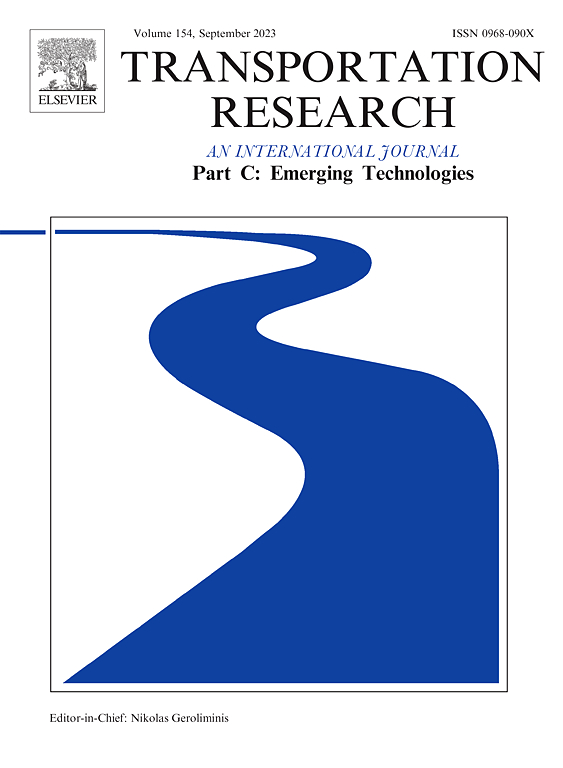活动感知城市区域嵌入对比学习在智能交通系统中的应用
IF 7.6
1区 工程技术
Q1 TRANSPORTATION SCIENCE & TECHNOLOGY
Transportation Research Part C-Emerging Technologies
Pub Date : 2025-07-06
DOI:10.1016/j.trc.2025.105252
引用次数: 0
摘要
嵌入是一种机器学习技术,它将数据实体表示为连续的向量表示,捕获它们之间的潜在语义关系。城市区域嵌入将这一概念应用于城市区域,将每个区域表示为包含其关键特征的向量。这些嵌入使模型能够更好地理解不同城市地区之间的关系,从而促进交通管理、城市规划和资源分配等应用。在本文中,我们提出了一个名为AUAEC(活动感知城市区域嵌入与对比学习)的综合框架,该框架集成了各种开放数据集,包括基于位置的社交网络(LBSN)签到、出租车流量数据和兴趣点(POI),以产生丰富的和上下文感知的区域嵌入。为了捕获LBSN用户的移动模式和活动感知语义,我们应用基于道路网络的空间插值,结合活动向量构建来表示用户的日常活动和运动模式。为了将这些嵌入细化为全面的城市区域表示,AUAEC结合了两种互补的对比学习策略:视图型对比学习,它将多个数据视图的表示对齐,以及活动感知型对比学习,它捕获基于活动感知语义的区域间关系。结果嵌入在四个关键ITS任务中进行评估,包括土地利用分布分类、交通事件预测、公共交通延误预测和使用现实世界数据的交通量预测。我们的方法展示了有希望的结果,优于最先进的解决方案,并突出了AUAEC在为ITS和城市规划应用提供强大的城市区域上下文表示方面的优势。本文章由计算机程序翻译,如有差异,请以英文原文为准。
Activity-aware urban area embedding with contrastive learning for intelligent transportation systems applications
Embedding is a machine learning technique that represents data entities as continuous vector representations, capturing the underlying semantic relationships between them. Urban area embedding applies this concept to urban regions, representing each area as a vector that encapsulates its key characteristics. These embeddings enable models to better understand the relationships between different urban areas, facilitating applications such as traffic management, urban planning, and resource allocation. In this paper, we propose a comprehensive framework called AUAEC (Activity-aware Urban Area Embedding with Contrastive Learning) that integrates diverse open datasets including Location-Based Social Network (LBSN) check-ins, taxi flow data, and Points of Interest (POI) to produce enriched and context-aware region embeddings. To capture both mobility patterns and activity-aware semantics of LBSN users, we apply spatial interpolation based on road network, coupled with activity vector construction to represent user daily activity and movement patterns. To refine these embeddings into comprehensive urban regional representations, the AUAEC incorporates two complementary contrastive learning strategies: View-wise Contrastive Learning, which aligns representations across multiple data views, and Activity-aware Contrastive Learning, which captures inter-region relationships based on activity-aware semantics. The resulting embeddings are evaluated across four critical ITS tasks including land use distribution classification, traffic incident prediction, public transport delay prediction and traffic volume prediction using real-world data. Our approach demonstrates promising results, outperforming state-of-the-art solutions and highlighting the superiority of AUAEC in providing robust, contextual representations of urban areas for ITS and urban planning applications.
求助全文
通过发布文献求助,成功后即可免费获取论文全文。
去求助
来源期刊
CiteScore
15.80
自引率
12.00%
发文量
332
审稿时长
64 days
期刊介绍:
Transportation Research: Part C (TR_C) is dedicated to showcasing high-quality, scholarly research that delves into the development, applications, and implications of transportation systems and emerging technologies. Our focus lies not solely on individual technologies, but rather on their broader implications for the planning, design, operation, control, maintenance, and rehabilitation of transportation systems, services, and components. In essence, the intellectual core of the journal revolves around the transportation aspect rather than the technology itself. We actively encourage the integration of quantitative methods from diverse fields such as operations research, control systems, complex networks, computer science, and artificial intelligence. Join us in exploring the intersection of transportation systems and emerging technologies to drive innovation and progress in the field.

 求助内容:
求助内容: 应助结果提醒方式:
应助结果提醒方式:


